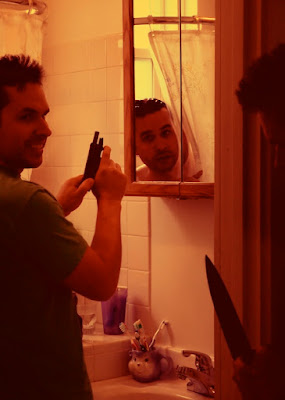This, the second in the series on the “21-foot rule” is written by Patrick Parker, of the venerable Mokuren Dojo blog. Patrick and I have enjoyed several years of banter, debate, and sincere mutual admiration since he started writing online, and I’ve grown to look forward to anytime he expresses an opinion, even if I don’t understand it. Sensei Pat runs a Judo and Aikido school in Mississippi, while, in Clark Kent fashion, appearing to the lay person as a physical therapist and PhD with some kids, living a normal life in the suburbs with a long honey-do list. Several times a week, ,however, in the evenings, the suit comes off, the gi and black belt goes on, and he transforms into a 6th-dan in aikido and 5th-dan in judo, both of which outrank and scare me. To preempt any threats or just looks of intimidation for not allowing him to play, I invited him to share his insights from his own context.
Cross-posted here at his site.
I'm not a law enforcement officer. I don't even play one on TV. In fact, I didn't even stay at the Holiday Inn Express last night. But Nathan at TDA Training did ask me to contribute some ideas to a week-long discussion of the famous Tueller Drill. Check out the video at Nathan's blog, and while you're at it, check out this gruesome example of the 21-foot rule played out in this police reel.
I enjoyed TGace's post about the flaws within the Tueller experiment and I appreciate his assertion that Tueller's results did not validate any sort of claim about the superiority of any particular weapon (a knife) over any other particular weapon (a gun). I intended to write this post on the idea that what Tueller does demonstrate most effectively is that a gun is not a magical talisman that automatically assures victory - but Paul at Tactical Arnis beat me to that point. Kudos to both of y'all for excellent, informative articles.
In my opinion, one of the take-away lessons from Tueller (perhaps unintended by the original author) is that a knife in the hand of a person with the right mindset is the most versatile, effective, gruesome, demoralizing weapon invented in the last several thousand years. Sure, the handgun is (I suppose) the centerpiece of police force projection, but again, the handgun is not a magic talisman. This point is effectively demonstrated by Tueller.
Also, Tueller's results were intended for police consumption. Using it to justify anything in the civilian self-defense context is a stretch - particularly because of the simple fact that most civilians will not have access to a handgun most of the time. But Tueller does illustrate an important point that is one of the centerpieces of our aikido system. That is...
You can never afford to underestimate the potential of your opponent.
Or, put another way, you have to treat every single training encounter as if your opponent is the most dangerous bad guy imaginable, armed with the most awful tactical advantage imaginable. Or, in shorter form, "You can never tell who you're standing beside." To us, that means we try to assume that all opponents are armed with a knife. You have to design your practices around the assumption that your opponent has the potential to kill you if they have the ability to touch you. That's pretty stringent, and it leads to practices like stab-twice randori, starting already stabbed, and progressive chaos.
As we have done knife randori like this over the years, we have come up with a few pretty reliable pieces of information. First, all of aikido (and probably most all of self-defense) is based on a couple of techniques that we call shomenate (A.K.A. the palm jab to the chin) and aigamaeate (A.K.A. iriminage, a palm jab to the chin done from outside the opponent's arm). The tactical idea behind both of these techniques is the same:
- get out of the way at least a little bit.
- get at least a little bit of control of the weapon arm
- crash into the opponent's center with your whole bodyweight, spearing into his head violently with a stiff-armed palm, locking his neck, and throwing him away.
- disengage and run away immediately.
All of our randori over the years has verified this basic idea - if you go into a knife encounter with any plan but the above, You're likely to get killed. But the above plan saves you a remarkable percentage of the time.
It turns out that all the other stuff in aikido - all the stuff you think of as aikido - the cool wristlocks and the airy breath throws - those are just backup plans. This basic plan enumerated above makes up easily 80% of aikido, and all the cool stuff fills in around the edges.
And you know what's cool? Tactical guru, Dave Spaulding agrees with me!
So, in summary of this somewhat rambling, stream of consciousness...
- Tueller is an interesting experiment that has implications primarily for police, but that us civilians can also learn from.
- A gun is not a magic talisman that assures victory - particularly if you allow you opponent within a few paces of you.
- A gun is a powerful and useful weapon, but IMO, a knife is demonstrably more versatile at close range.
- You can never afford to underestimate your opponent's potential. You must take this idea into every single training encounter.
- You need some variety and speed and resistance in your knife defense practice - not just the slow zombie attack over and over again.
- You have to have a fundamental tactical plan that makes up the vast majority of your system that is simple, easy to remember, works under pressure, and involves evasion, automatic control, and immediately-disabling atemiwaza (strikes)
[photo courtesy of Jesse Millan]
____________________
Patrick Parker


No comments:
Post a Comment